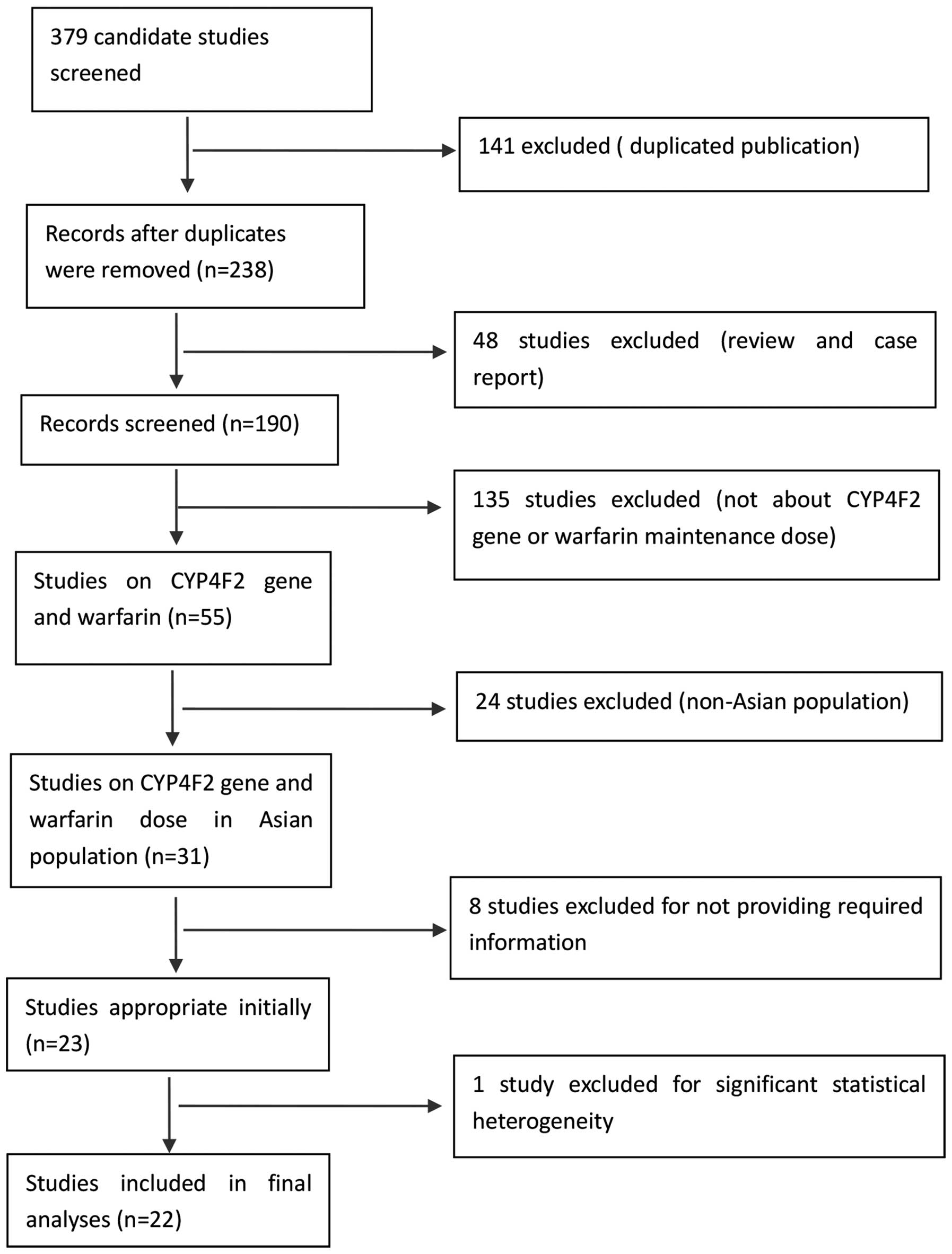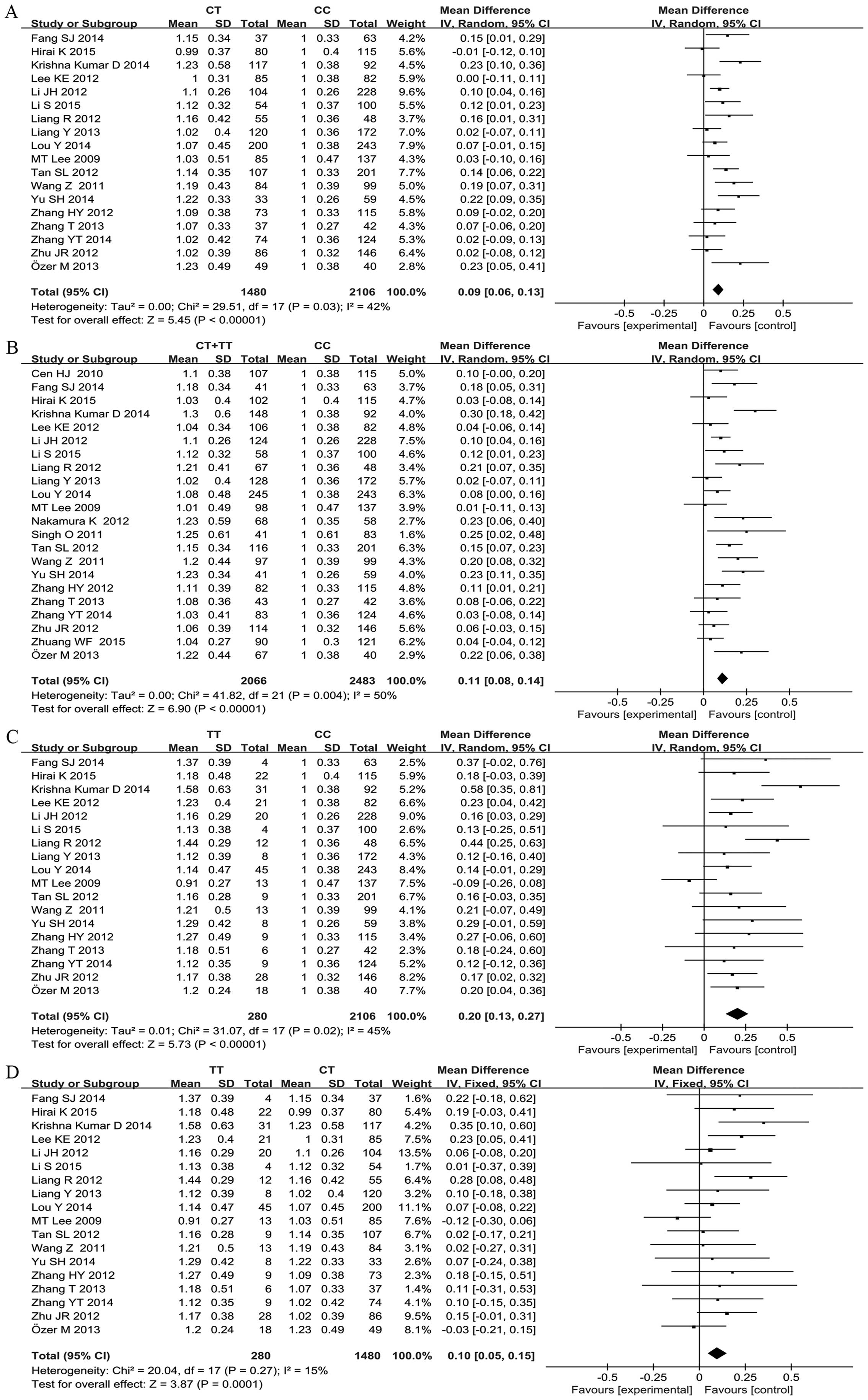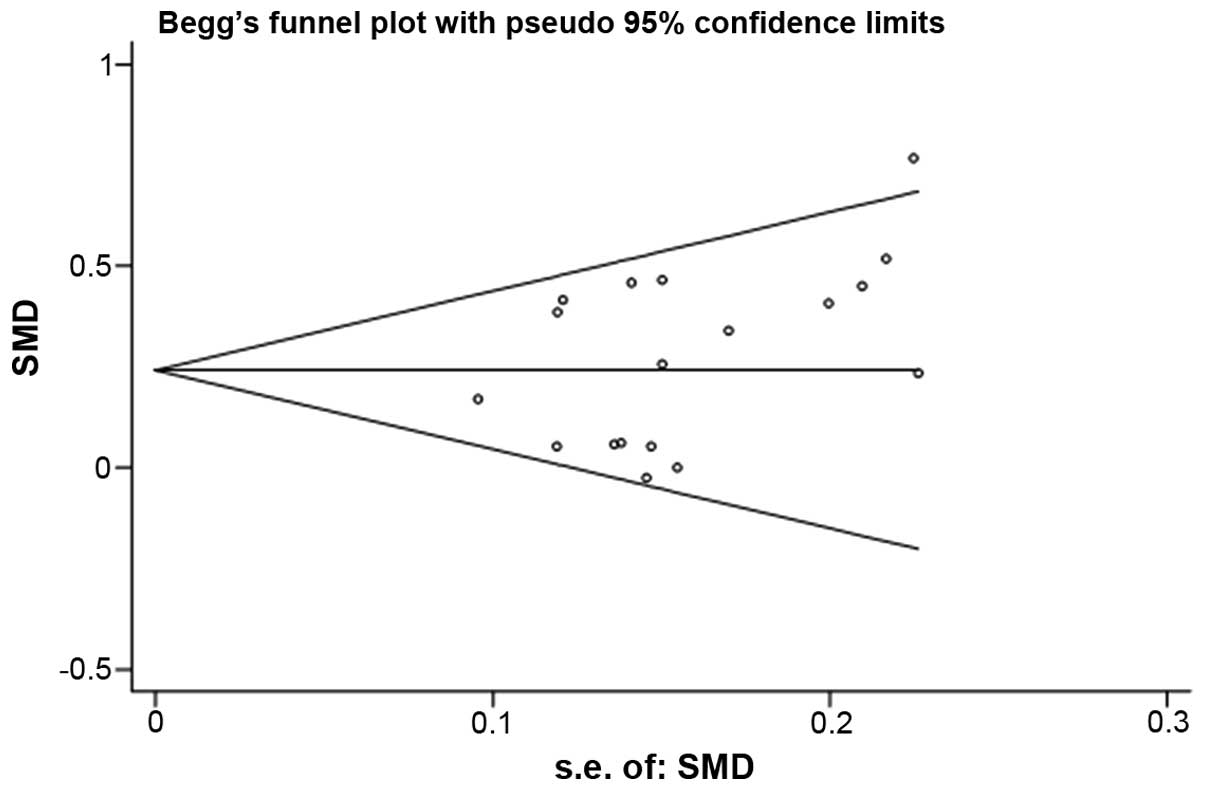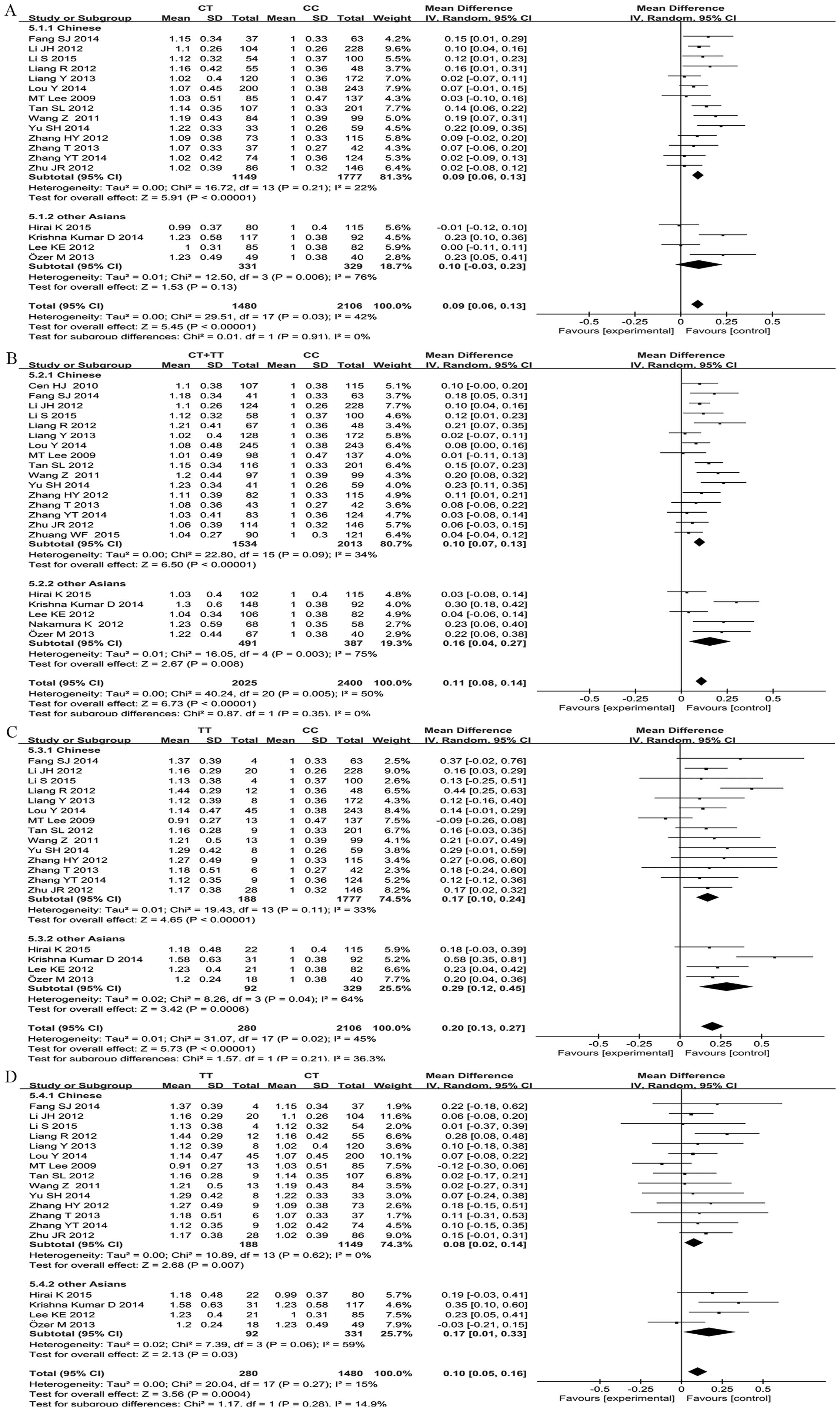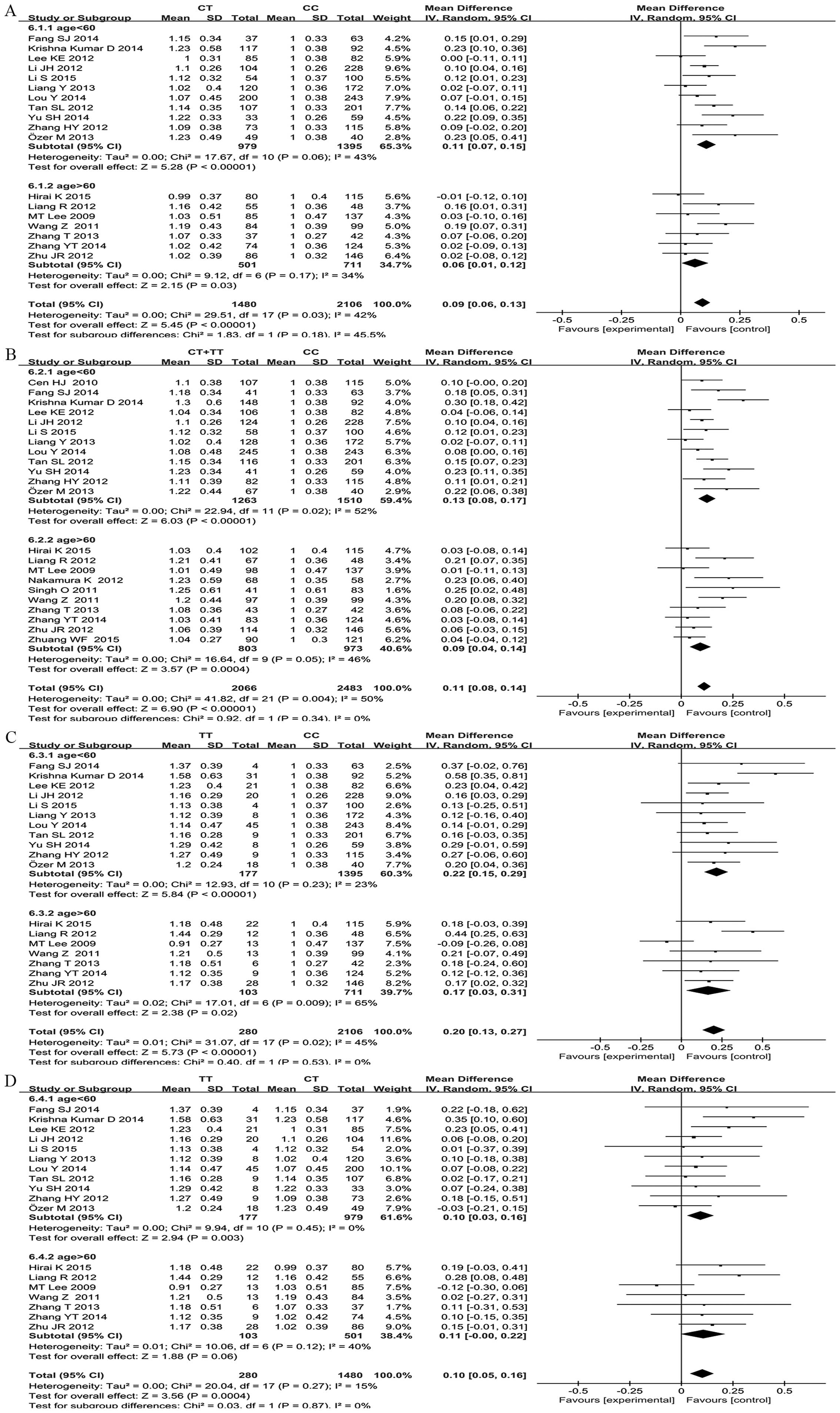Impact of the CYP4F2 gene polymorphisms on the warfarin maintenance dose: A systematic review and meta-analysis
- Authors:
- Published online on: February 15, 2016 https://doi.org/10.3892/br.2016.599
- Pages: 498-506
Abstract
Introduction
Warfarin is a commonly oral anticoagulant, mainly used clinically in the treatment of thromboembolic diseases, such as atrial fibrillation (AF) and deep venous thrombosis (DVT); however, the existence of high interpatient variability in drug dosage may increase the risk of bleeding or thrombosis. Studies indicated that individual warfarin dose was influenced by a host of factors, including genetic and environmental factors. Genetic factors are one of the main reasons for the individual difference in warfarin maintenance dosage. Previous studies have also suggested that cytochrome P450 complex subunit 2C9 (CYP2C9) and vitamin K epoxide reductase complex subunit 1 (VKORC1) polymorphisms, age, weight and body surface area can explain ~50% of the influence on warfarin dose requirement (1–6). Therefore, there remains a 50% uncertainty of the other factors to be further explored.
The cytochrome P450 4F2 (CYP4F2) gene, consisting of 13 exons and 12 introns and encoding 520 amino acid residues, is located on chromosome 19p13.12 in humans. Studies have shown that there are numerous single-nucleotide polymorphisms (SNPs) in the CYP4F2 gene open reading frame, such as rs2108622, rs2074901 and rs2189784. Genome-wide association studies identified that the SNP associated with warfarin dose is CYP4F2 p.V433M (rs2108622) in exon 11 (7). VKOR is mainly encoded by CYP4F2, which reduces VK1 by metabolizing VK1 to hydroxy VK1. Studies have also demonstrated that carriers of the CYP4F2 p.V433M variant allele have a reduced capacity to metabolize VK1, and therefore, a higher warfarin dose was required to elicit the same anticoagulant response (8).
Since Caldwell et al (9) reported for the first time in 2008 that CYP4F2 gene variants would change the warfarin maintenance dose in patients, an increasing number of research results regarding the correlation between the CYP4F2 gene polymorphism and warfarin dose have been published. However, the findings are inconsistent, particularly for Asian patients (10–15). In 2012, two results of meta-analyses showed that the CYP4F2 gene polymorphism was associated with the warfarin maintenance dosage (16,17). However, as they all focused on the studies of European and American populations, the impact of the CYP4F2 genotype on warfarin dose in the Asian population has not been investigated adequately. Furthermore, following the publication of these 2 meta-analyses, new research results regarding the association between the CYP4F2 polymorphism and warfarin maintenance dose in Asian patients remains inconsistent. Thus, the aim of the present study was to investigate the effect of the CYP4F2 genotype on warfarin maintenance dose in the Asian population by a meta-analysis.
Materials and methods
Search strategy of the literature
The literature search was conducted in PubMed, EMBASE and China National Knowledge Infrastructure databases (until August 5, 2015). There was no limitation in the date of publication or language. The search keywords were (warfarin* OR coumarin) AND (gene OR genotype OR genetics OR allele* OR polymorphism* OR variant* OR pharmacogenetics) AND (CYP4F2). Under the circumstances of missing data or ambiguity, the authors were contacted for additional information.
Study selection
The original studies published in full text were included. Reviews, case reports and editorials were excluded. In addition, the studies that were not of an Asian population, that did not include genotype frequencies or warfarin maintenance dose, and that did not include the indispensable information from the authors contacted were excluded. The following criteria were used to select the appropriate studies: і) Studies on Asian patients >18 years treated with warfarin; іі) CYP4F2 genotyping performed in all patients or in a random selection of patients; and ііі) warfarin maintenance dose (mean and standard deviation) available separately for CC, CT and TT genotypes or for the dominant model. There were no restrictions in the inclusion criteria with respect to patient demographic information.
Data extraction
Data of all the eligible studies were extracted and summarized independently by two reviewers. The recorded original information included the first author, the year of publication, country, the total sample size (the percentage of males), mean age, indication of warfarin, target international normalized ratio range, allele frequencies of CYP4F2 and warfarin maintenance dose.
Quality score assessment
Two reviewers assessed the quality of the selected studies independently according to the Cochrane handbook and the criteria predefined by Little et al (18). The quality criteria were: і) Purpose of the study; іі) analytic validity of genotyping (types of samples used, timing of sample collection and analysis, genotyping method and quality control measures); ііі) selection of the study subjects (geographic area, recruitment period, exclusion criteria, mean age and standard deviation or age range of study subjects, and the distribution by gender); and іv) statistical issues (methods of analysis used in reference and software used in the analysis). A study was graded as ‘++’, ‘+’ or ‘-’ according to the satisfaction degree of the aforementioned criteria.
Statistical analysis
In order to eliminate any heterogeneity among different study populations, the maintenance dose of warfarin was normalized for each CYP4F2 genotype group using the CYP4F2 CC genotype as a reference. The normalization process was conducted by dividing the mean dose and associated standard deviations in each group by the mean maintenance dose in the CYP4F2 CC group according to Lindh et al (19). Carriers of the CT or TT genotype were defined as ‘T carriers’.
The association between the mean daily warfarin dose (MDWD) and CYP4F2 gene polymorphisms was analyzed using the Review Manager 5.3 software (2014; The Nordic Cochrane Centre, The Cochrane Collaboration, Copenhagen, Denmark). The normalized doses in the three genotype groups (CT, TT and T carriers) were compared with the CC genotype (reference group) by 3 meta-analyses. The TT genotype was compared with the CT genotype. The studies were weighted by the inverse variance method, and the effect of each CYP4F2 genotype on the warfarin dose was defined as the mean difference (MD). The calculated MDs represent the relative differences in the maintenance dose due to the normalization procedure. The total weighted MD (WMD) is the sum of the WMD for each study. Z-test was employed to examine the effect of the CYP4F2 SNP on MDWD, and P<0.05 was considered to indicate a statistically significant difference.
Heterogeneity among studies was estimated by the Cochran's Q-statistic and I2 tests. In the case of studies with statistical heterogeneity (P<0.1 or I2 >50%), the random-effect model was selected. Otherwise, the fixed-effect model was used.
Sensitivity analyses were performed by two methods. The first method removed studies one by one, and the second switched the meta-analysis between the fixed-effect model and random-effect model. Begg's funnel plot and Egger's linear regression test were applied to evaluate the publication bias with the use of STATA software version 12.0 (StataCorp LP, College Station, TX, USA), and P<0.05 was considered to indicate a statistically significant difference.
Subgroup analyses were carried out to identify the potential explanatory variables. The Chinese and non-Chinese Asian population studies were defined as two separate subgroups. As age was an important influence factor, the data was also divided into two according to the mean age of <60 years old and >60 years old. The main analysis was repeated separately in each subgroup.
Results
Literature selection
Fig. 1 shows the selection process of the eligible studies. A total of 379 candidate studies were included in the initial search. Following exclusion of the repeated and unfitted studies, 22 studies with a total of 4,549 patients conformed to the inclusion criteria for the qualitative data analysis.
Study characteristics
Table I expresses the characteristics of these 22 studies included in the meta-analysis. The publication years of the eligible studies ranged between 2009 and 2015. Among the included studies, the majority were of Chinese patients (10–15,20–25). Five studies were of non-Chinese populations (26–30) and one was for an Asian population (31). The main indications of warfarin were heart valve replacement, AF, DVT, pulmonary embolism and stroke.
Allele frequencies
There were 3,646 Chinese and 903 non-Chinese Asian patients included in the final analysis. On average, the frequencies of CC, CT and TT were 0.53, 0.39 and 0.08 in all the selected Asian patients. The frequencies of CC, CT and TT were 0.57, 0.37 and 0.06 in the Chinese patients and 0.44, 0.45 and 0.11, respectively, in the non-Chinese Asian patients. SPSS 18.0 (SPSS, Inc., Chicago, IL, USA) was used to assess the difference of allele frequencies between the two subgroups, and there was a significantly statistical difference (P<0.05).
Meta-analysis results
Fig. 2 shows the influence of each CYP4F2 genotype on the warfarin maintenance dose. Compared with individuals with the homozygous CC genotype, warfarin doses in patients with genotype CT, TT and T carriers were significantly higher by 9 [95% confidence interval (CI), 6.0–13.0], 20 (95% CI, 13.0–27.0) and 11% (95% CI, 8.0–14.0), respectively (test for overall effect was P<0.05). Additionally, compared with the CT carriers, the TT carriers required a higher warfarin dose by 10% (95% CI, 5.0–15.0) with statistical significance (P<0.05).
Heterogeneity analysis
Only one meta-analysis showed no statistical heterogeneity (Cochran's Q test P=0.22, I2 value 15%), and a fixed-effects model was used in the analysis. However, statistical heterogeneity was evident across the other meta-analyses in which the random-effects model was applied.
Sensitive analysis and publication bias
The first method of sensitivity analysis was performed by deselecting each study one at a time. When deselecting the study of Luo et al (2013, unpublished data), the I2 decreased from 74 to 42%, indicating that the study is the source of statistical heterogeneity. Further analysis showed that the heterogeneity may have been due to several design differences among the studies, including lower mean age and the definition of stable warfarin dose in the inclusion criteria. Following this, the study was excluded in the final analysis. Subsequently, the sensitivity was analyzed using the random-effect model, in which the results of the parameter analysis were in accordance with those using the fixed-effect model, suggesting that the results were stable.
Publication bias was evaluated by Begg's funnel plot and Egger's linear regression test. Fig. 3 showed the Begg's funnel plot of the main studies included in the meta-analysis. One study was outside the excepted 95% CI. The Egger regression test indicated no significant publication bias across the studies (t=1.65, P=0.119).
Subgroup analysis
Considering the multiple difference between Chinese and non-Chinese Asian populations, a subgroup analysis was performed and the results are presented in Fig. 4. Non-Chinese CT and TT carriers showed an ~1 and 12% larger effect on warfarin dose requirement compared to Chinese patients. Non-Chinese T carriers showed ~6% larger effect by comparison with Chinese patients. Fig. 5 shows the subgroup analyses of different age intervals. CT and TT carriers <60 years old showed an ~5 and 4% larger effect on warfarin dose requirement than that of patients >60 years. However, these differences were not significant (P>0.05).
Discussion
The incidence of thromboembolic disease ranks first among various diseases, showing an increasing tendency each year. New oral anticoagulants, such as rivaroxaban and apixaban, have the advantage of safe, effective and significant reduction in intracranial hemorrhage and no requirement for routine laboratory monitoring. However, they have the defects of higher drug prices and the absence of a suitable antidote. Currently, warfarin remains the primary anticoagulation drug for treatment of AF and other thromboembolic diseases. There is a large individual difference in warfarin dose requirement. Genetic variation shows a clinically important impact on stable warfarin dose. The association between CYP2C9, VKORC1 and warfarin dose has been investigated in several meta-analysis (19,32–34), and the influence of these two genes on warfarin dose has been confirmed. Data showed that CYP2C9 and VKORC1 together with clinical factors such as age, weight and drug combination can explain only ~50% of warfarin dose variability, suggesting that 50% uncertain factors remain to be considered. Thus far, only CYP2C9 and VKORC1 as genetic factors are included in a multitude of pharmacogenetic models, and CYP4F2 may have the third major influence among genetic factors. Studies regarding whether CYP4F2 affects warfarin dose requirement are consecutive; however, the results of different studies are controversial, particularly for Asian population studies. One possible explanation could be that the sample size in these studies is too small. Therefore, summarizing the scattered sample data to analyze the association between CYP4F2 and warfarin dose requirement in Asian populations is likely to get effectual results.
Although the findings regarding the correlation between the CYP4F2 polymorphism and warfarin dose in the Asian population are inconsistent, the results of the present systematic review and meta-analysis showed a strong association between CYP4F2 polymorphisms and warfarin maintenance dose. Using a systematic search strategy, 22 studies that met the prespecified eligibility criteria were selected. Carriers of the CT and TT genotypes required 9 and 20% higher warfarin doses compared to carriers of the CC genotype, respectively. Additionally, T carriers required a warfarin dose 11% higher than the CC genotype. Furthermore, TT carriers required a 10% higher warfarin dose compared to the CT group (all P<0.05).
With regard to the sensitivity analysis, following the exclusion of the study by Luo et al, any significant change or revision in findings was not identified, and the results of the parameter analysis using the random-effect model were in accordance with those using the fixed-effect model, so therefore, the meta-analysis results of the impact of CYP4F2 genotype on warfarin dose requirements were considered stable and reliable.
Limdi et al (35) proposed that the effect of predictors including clinical and genetic factor on warfarin dose differs by ethnicities. In the subgroup analyses, minor but no significant differences were observed between the Chinese and non-Chinese population. The results were similar in different age ranges. However, the heterogeneity of the Chinese group was reduced compared with the undifferentiated patients, and there was a significant difference in the allele gene frequencies of CYP4F2 between Chinese and non-Chinese Asian populations. The aforementioned results are indicative of a minor difference between the Chinese and non-Chinese patients. Due to the small number of non-Chinese Asian patients included in the present analysis, the results required further verification.
The systematic review and meta-analysis confirmed the association between warfarin and CYP4F2 rs2108622 in the Asian population. The results will aid further research of pharmacogenetics model, and improve the antithrombotic therapy of warfarin. To the best of our knowledge, this is the first study to explore the association between CYP4F2 and the warfarin stable dose solely for the Asian population. As opposed to the studies by Danese et al (16) and Liang et al (17), a statistical difference was observed between the CT and TT genotype, which may be an indication of a larger effect of CYP4F2 on the warfarin dose in the Asian population.
There are several limitations to the present meta-analysis. Firstly, the data for warfarin mean maintenance dose in the meta-analysis was not adjusted for other predictors. Secondly, certain studies were not included in the meta-analysis due to the absence of sufficient data. Thirdly, data of certain non-Chinese Asian studies was unavailable, leading to a smaller number of studies for the non-Chinese Asian population.
More studies with larger sample sizes are required in the future to investigate the effect of CYP4F2 on a stable warfarin dose requirement, particularly considering the adjustment for the CYP2C9 and VKORC1 genes.
In conclusion, the present meta-analysis provides evidence that CYP4F2 rs2108622 may influence the maintenance dose of warfarin in the Asian population and can address the controversy that has emerged in recent years to a certain extent. However, whether the impact of CYP4F2 on warfarin dose is clinically important requires further investigation.
Acknowledgements
The authors would like to thank Dr Chen and Dr Hirai for providing original data. The study was supported by the International Science and Technology Cooperation Program of China (grant no. 2014DFA30900), the National Scientific Foundation of China (grant nos. 81373476, 81301924 and 81302851), the Scientific Foundation of Hunan Province (grant nos. 11JJ2054 and 14JJ7016) and the Science and Technology Plan of Changsha (grant no. k1403065-31).
References
|
Klein TE, Altman RB, Eriksson N, Gage BF, Kimmel SE, Lee MT, Limdi NA, Page D, Roden DM, Wagner MJ, et al: International Warfarin Pharmacogenetics Consortium: Estimation of the warfarin dose with clinical and pharmacogenetic data. N Engl J Med. 360:753–764. 2009. View Article : Google Scholar : PubMed/NCBI | |
|
Zhu Y, Shennan M, Reynolds KK, Johnson NA, Herrnberger MR, Valdes R Jr and Linder MW: Estimation of warfarin maintenance dose based on VKORC1 (−1639 G>A) and CYP2C9 genotypes. Clin Chem. 53:1199–1205. 2007. View Article : Google Scholar : PubMed/NCBI | |
|
Gage BF, Eby C, Johnson JA, Deych E, Rieder MJ, Ridker PM, Milligan PE, Grice G, Lenzini P, Rettie AE, et al: Use of pharmacogenetic and clinical factors to predict the therapeutic dose of warfarin. Clin Pharmacol Ther. 84:326–331. 2008. View Article : Google Scholar : PubMed/NCBI | |
|
Ohno M, Yamamoto A, Ono A, Miura G, Funamoto M, Takemoto Y, Otsu K, Kouno Y, Tanabe T, Masunaga Y, et al: Influence of clinical and genetic factors on warfarin dose requirements among Japanese patients. Eur J Clin Pharmacol. 65:1097–1103. 2009. View Article : Google Scholar : PubMed/NCBI | |
|
Cini M, Legnani C, Cosmi B, Guazzaloca G, Valdrè L, Frascaro M and Palareti G: A new warfarin dosing algorithm including VKORC1 3730 G>A polymorphism: Comparison with results obtained by other published algorithms. Eur J Clin Pharmacol. 68:1167–1174. 2012. View Article : Google Scholar : PubMed/NCBI | |
|
Huang SW, Chen HS, Wang XQ, Huang L, Xu DL, Hu XJ, Huang ZH, He Y, Chen KM, Xiang DK, et al: Validation of VKORC1 and CYP2C9 genotypes on interindividual warfarin maintenance dose: A prospective study in Chinese patients. Pharmacogenet Genomics. 19:226–234. 2009. View Article : Google Scholar : PubMed/NCBI | |
|
Teichert M, Eijgelsheim M, Rivadeneira F, Uitterlinden AG, van Schaik RH, Hofman A, De Smet PA, van Gelder T, Visser LE and Stricker BH: A genome-wide association study of acenocoumarol maintenance dosage. Hum Mol Genet. 18:3758–3768. 2009. View Article : Google Scholar : PubMed/NCBI | |
|
McDonald MG, Rieder MJ, Nakano M, Hsia CK and Rettie AE: CYP4F2 is a vitamin K1 oxidase: An explanation for altered warfarin dose in carriers of the V433M variant. Mol Pharmacol. 75:1337–1346. 2009. View Article : Google Scholar : PubMed/NCBI | |
|
Caldwell MD, Awad T, Johnson JA, Gage BF, Falkowski M, Gardina P, Hubbard J, Turpaz Y, Langaee TY, Eby C, et al: CYP4F2 genetic variant alters required warfarin dose. Blood. 111:4106–4112. 2008. View Article : Google Scholar : PubMed/NCBI | |
|
Lee MT, Chen CH, Chou CH, Lu LS, Chuang HP, Chen YT, Saleem AN, Wen MS, Chen JJ, Wu JY, et al: Genetic determinants of warfarin dosing in the Han-Chinese population. Pharmacogenomics. 10:1905–1913. 2009. View Article : Google Scholar : PubMed/NCBI | |
|
Liang R, Li L, Li C, Gao Y, Liu W, Hu D and Sun Y: Impact of CYP2C9*3, VKORC1-1639, CYP4F2rs2108622 genetic polymorphism and clinical factors on warfarin maintenance dose in Han-Chinese patients. J Thromb Thrombolysis. 34:120–125. 2012. View Article : Google Scholar : PubMed/NCBI | |
|
Li JH, Ma GG, Zhu SQ, Yan H, Wu YB and Xu JJ: Correlation between single nucleotide polymorphisms in CYP4F2 and warfarin dosing in Chinese valve replacement patients. J Cardiothorac Surg. 7:972012. View Article : Google Scholar : PubMed/NCBI | |
|
Liang Y, Chen Z, Guo G, Dong X, Wu C, Li H, Wang T and Xu B: Association of genetic polymorphisms with warfarin dose requirements in Chinese patients. Genet Test Mol Biomarkers. 17:932–936. 2013. View Article : Google Scholar : PubMed/NCBI | |
|
Li S, Zou Y, Wang X, Huang X, Sun Y, Wang Y, Dong L and Jiang H: Warfarin dosage response related pharmacogenetics in Chinese population. PLoS One. 10:e01164632015. View Article : Google Scholar : PubMed/NCBI | |
|
Zhuang W, Wen W, Xuan B, Chen Y, Cao Y, Sun Z and Ma J: Effect of CYP2C9, CYP4F2 and VKORC1 genetic polymorphisms on pharmacokinetics and pharmacodynamics of mean daily maintenance dose of warfarin in Chinese patients. Blood Coagul Fibrinolysis. 26:167–174. 2015. View Article : Google Scholar : PubMed/NCBI | |
|
Danese E, Montagnana M, Johnson JA, Rettie AE, Zambon CF, Lubitz SA, Suarez-Kurtz G, Cavallari LH, Zhao L, Huang M, et al: Impact of the CYP4F2 p.V433M polymorphism on coumarin dose requirement: Systematic review and meta-analysis. Clin Pharmacol Ther. 92:746–756. 2012. View Article : Google Scholar : PubMed/NCBI | |
|
Liang R, Wang C, Zhao H, Huang J, Hu D and Sun Y: Influence of CYP4F2 genotype on warfarin dose requirement-a systematic review and meta-analysis. Thromb Res. 130:38–44. 2012. View Article : Google Scholar : PubMed/NCBI | |
|
Little J, Bradley L, Bray MS, Clyne M, Dorman J, Ellsworth DL, Hanson J, Khoury M, Lau J, O'Brien TR, et al: Reporting, appraising, and integrating data on genotype prevalence and gene-disease associations. Am J Epidemiol. 156:300–310. 2002. View Article : Google Scholar : PubMed/NCBI | |
|
Lindh JD, Holm L, Andersson ML and Rane A: Influence of CYP2C9 genotype on warfarin dose requirements - a systematic review and meta-analysis. Eur J Clin Pharmacol. 65:365–375. 2009. View Article : Google Scholar : PubMed/NCBI | |
|
Cen HJ, Zeng WT, Leng XY, Huang M, Chen X, Li JL, Huang ZY, Bi HC, Wang XD, He YL, et al: CYP4F2 rs2108622: A minor significant genetic factor of warfarin dose in Han Chinese patients with mechanical heart valve replacement. Br J Clin Pharmacol. 70:234–240. 2010. View Article : Google Scholar : PubMed/NCBI | |
|
Lou Y, Han L and Li Y, Zhang X, Liu Z, Tang M, Yu H, Wang W, Xu J, Liu H and Li Y: Impact of six genetic polymorphisms on Warfarin maintenance dose variation in Chinese Han population. Zhonghua Yi Xue Yi Chuan Xue Za Zhi. 31:367–371. 2014.(In Chinese). PubMed/NCBI | |
|
Zhang HY, Luo WW, Fang HR, Yang XQ, Xu LH and Ma SM: Influence of VKORC1, CYP2C9, CYP4F2 and EPHX1 Gene Polymorphisms on Warfarin Dose. China Pharmacy. 34:3201–3205. 2012. | |
|
Zhu JR, Zhu YB, Xie DJ, Ye F and Tao YF: Effects of CYP4F2, CYP2C9 and VKORC1 genetic polymorphisms on maintenance dosage of warfarin in Chinese Han nationality patients with non-valve atrial fibrillation. China Pharmacy. 44:4161–4164. 2012. | |
|
Wang Z, Yang D, Li YL, et al: Influence of CYP4F2 gene polymorphisms on warfarin dose. Guangdong Medical Journal. 3091–3094. 2011. | |
|
Zhang YT, Liang X, Dong F, et al: Effect of CYP4F2 polymorphism on warfarin anticoagulant in Chinese population. Clinical Medication Journal. 41–59. 2014. | |
|
Krishna Kumar D, Shewade DG, Loriot MA, Beaune P, Balachander J, Sai Chandran BV and Adithan C: Effect of CYP2C9, VKORC1, CYP4F2 and GGCX genetic variants on warfarin maintenance dose and explicating a new pharmacogenetic algorithm in South Indian population. Eur J Clin Pharmacol. 70:47–56. 2014. View Article : Google Scholar : PubMed/NCBI | |
|
Özer M, Demirci Y, Hizel C, Sarikaya S, Karalti İ, Kaspar Ç, Alpan S and Genç E: Impact of genetic factors (CYP2C9, VKORC1 and CYP4F2) on warfarin dose requirement in the Turkish population. Basic Clin Pharmacol Toxicol. 112:209–214. 2013. View Article : Google Scholar : PubMed/NCBI | |
|
Hirai K, Yamada Y, Hayashi H, Tanaka M, Izumiya K, Suzuki M, Yoshizawa M, Moriwaki H, Akimoto T, Tsuji D, et al: Plasma vitamin K concentrations depend on CYP4F2 polymorphism and influence on anticoagulation in Japanese patients with warfarin therapy. Thromb Res. 135:861–866. 2015. View Article : Google Scholar : PubMed/NCBI | |
|
Nakamura K, Obayashi K, Araki T, Aomori T, Fujita Y, Okada Y, Kurabayashi M, Hasegawa A, Ohmori S, Nakamura T, et al: CYP4F2 gene polymorphism as a contributor to warfarin maintenance dose in Japanese subjects. J Clin Pharm Ther. 37:481–485. 2012. View Article : Google Scholar : PubMed/NCBI | |
|
Lee KE, Chang BC, Kim HO, Yoon IK, Lee NR, Park HY and Gwak HS: Effects of CYP4F2 gene polymorphisms on warfarin clearance and sensitivity in Korean patients with mechanical cardiac valves. Ther Drug Monit. 34:275–282. 2012. View Article : Google Scholar : PubMed/NCBI | |
|
Singh O, Sandanaraj E, Subramanian K, Lee LH and Chowbay B: Influence of CYP4F2 rs2108622 (V433M) on warfarin dose requirement in Asian patients. Drug Metab Pharmacokinet. 26:130–136. 2011. View Article : Google Scholar : PubMed/NCBI | |
|
Jorgensen AL, FitzGerald RJ, Oyee J, Pirmohamed M and Williamson PR: Influence of CYP2C9 and VKORC1 on patient response to warfarin: A systematic review and meta-analysis. PLoS One. 7:e440642012. View Article : Google Scholar : PubMed/NCBI | |
|
Yang L, Ge W, Yu F and Zhu H: Impact of VKORC1 gene polymorphism on interindividual and interethnic warfarin dosage requirement - a systematic review and meta analysis. Thromb Res. 125:e159–e166. 2010. View Article : Google Scholar : PubMed/NCBI | |
|
Jin B, Hong Y, Zhu J, Li Y and Shi HM: The impact of VKORC1-1639G>A genetic polymorphism upon warfarin dose requirement in different ethnic populations. Curr Med Res Opin. 30:1505–1511. 2014. View Article : Google Scholar : PubMed/NCBI | |
|
Limdi NA, Brown TM, Yan Q, Thigpen JL, Shendre A, Liu N, Hill CE, Arnett DK and Beasley TM: Race influences warfarin dose changes associated with genetic factors. Blood. 126:539–545. 2015. View Article : Google Scholar : PubMed/NCBI |



